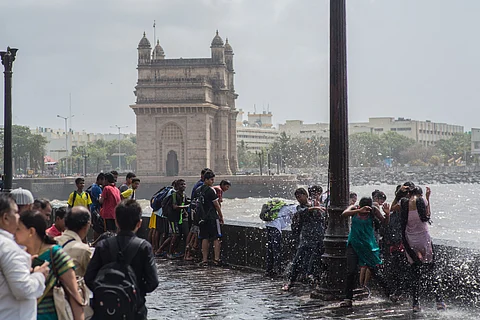

Monsoon systems around the world – including India’s southwest monsoon, which delivers over 70 per cent of the country’s annual rainfall – possess physical memories in the form of stored water vapour, according to a study published on May 6, 2025 in the journal PNAS by the Potsdam Institute for Climate Impact Research (PIK), Germany.
The onset of monsoons in spring or ‘switching on’ and their retreat or ‘switching off’ in autumn appeared to depend not solely on incoming solar radiation, as previously believed, but also on the cumulative build-up of atmospheric moisture over time, the researchers found.
“It allows monsoon systems to flip between two stable states. Disrupting this delicate balance would have severe consequences for billions of people, in India, Indonesia, Brazil and China,” stated a press release issued by PIK on May 7, 2025.
The study, led by scientists Anja Katzenberger and Anders Levermann of the institute, combined observational data from monsoon regions in India, China and elsewhere with simulations of atmospheric dynamics. Their findings suggested that “the state of the atmosphere depends on its seasonal history”.
To conduct their simulations, the researchers used an atmospheric circulation model developed at Princeton University. This model allowed them to isolate atmospheric processes from slower-changing components of the Earth system, such as the oceans.
The results highlighted a self-reinforcing pattern in monsoon behaviour. For instance, if it is already raining in a place, it will likely continue to rain. Conversely, dry conditions make it harder to initiate rainfall, the authors noted.
“In practical terms, this means that even though solar radiation increases or decreases with the seasons, the atmosphere doesn’t always respond immediately,” Katzenberger explained in the press release. “During spring, water vapour accumulates over days and weeks. This reservoir determines the onset of monsoon rainfall in early summer and maintains it even as solar influx starts to decline in autumn.”
This behaviour is known as hysteresis — a phenomenon where there is a lag between an input to a complex system, such as the monsoon, and its response, with the system’s behaviour shaped by its own history as well as current inputs.
Even after the input is removed, the system continues to exhibit some of its effects. In the case of monsoons, the input is solar radiation and the effect is rainfall. This kind of hysteresis behaviour is also observed in other fields — for instance, in magnetism and in economics, where systems often retain the impact of a shock long after the initial cause, such as a recession, has passed.
This is the first time that a mechanism for long term atmospheric memory has been proposed. “We’ve long known that systems like the ocean or the massive ice sheets have some sort of memory. But the atmosphere? That was thought impossible,” said Levermann who heads the department of Complexity Science at PIK.
The researchers linked the sudden switching of the monsoon season to broader tipping elements in the Earth’s climate system, such as the Arctic and Antarctic ice sheets and the Amazon rainforest.
“What’s particularly notable is that the monsoon crosses its tipping point every year and then returns. This could enable us in the future to actually identify the tipping point with observational data and develop an early warning system,” Levermann added.
The simulations showed that monsoon rainfall could flip between dry and wet states without requiring the thermal inertia provided by the ocean. The key to this monsoon behaviour lies in a column of atmospheric moisture that sustains rainfall for weeks and also serves as the system’s tipping point.
“When atmospheric water vapour exceeds around 35 kilograms per square metre, the monsoon switches on. If it falls below that, it switches off. This abrupt, threshold-based response defines the bistability,” said Katzenberger.
When the stable monsoon system, shaped over millions of years, is disrupted by external influences — primarily anthropogenic factors like atmospheric pollution and global warming — it could lead to major, yet still poorly understood, consequences. “It would disrupt not only our climate system, but our societies worldwide,” Levermann concluded.
Whether current monsoon systems are at risk of abrupt collapse remains an open question. This “needs to be investigated in future studies,” the paper stated.